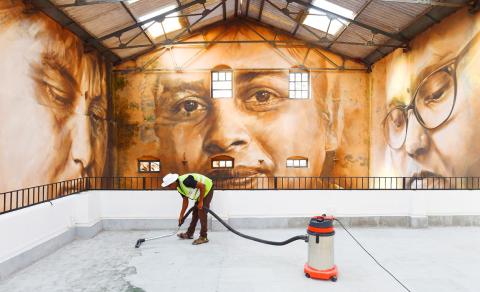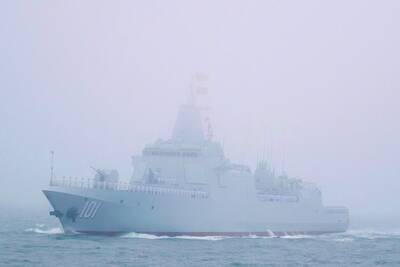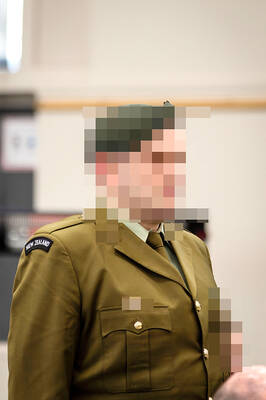Indian fishers unload their morning catch as sari-clad women carrying buckets on their heads walk past street art that has transformed one of Mumbai’s oldest fishing docks into an exhibition space.
Thirty artists from around the world have given the bustling 142-year-old Sassoon Dock, home to Mumbai’s traditional Koli fishing community, a colorful makeover as part of the St+art Urban Art Festival.
“The artworks range from mixed media to graffiti to street-art styles to installations, from using paints to wood to fishing objects,” cofounder and director Arjun Bahl said.

Photo: AFP
Exhibits include large portraits of Koli fishers — believed to be Mumbai’s original inhabitants and whose goddess Mumbadevi lends her name to the city — and brightly painted murals representing women from the community.
One installation, entitled Parfum Sassoon, alludes to the dock’s notoriously pungent fishy smell while another has a clear environmental message with its depiction of plastic bottles floating through the ocean.
The Sassoon Dock project is part of the seventh edition of the festival, which aims to make art accessible to everyone by transforming a public space.
“The whole idea was to bring art to a certain sect of the community who usually don’t interact with art,” Bahl said as dock workers pushed trolleys loaded with fish and boats bobbed gently in the harbor.
Sassoon Dock was built in 1875 and is home to one of Mumbai’s largest fish markets. It is in the district of Colaba, in the southern tip of India’s financial capital.
The exhibition, which is free to view, opened to the public on Saturday and runs until Dec. 30. It will also feature screenings, talks and tours.
Another feature of the festival is a giant, multicolored mural on the nearby Churchgate railway station showing India’s independence movement leader Mahatma Gandhi stepping down from a train. It was painted by popular Brazilian street artist Eduardo Kobra.

ELECTION DISTRACTION? When attention shifted away from the fight against the militants to politics, losses and setbacks in the battlefield increased, an analyst said Recent clashes in Somalia’s semi-autonomous Jubaland region are alarming experts, exposing cracks in the country’s federal system and creating an opening for militant group al-Shabaab to gain ground. Following years of conflict, Somalia is a loose federation of five semi-autonomous member states — Puntland, Jubaland, Galmudug, Hirshabelle and South West — that maintain often fractious relations with the central government in the capital, Mogadishu. However, ahead of elections next year, Somalia has sought to assert control over its member states, which security analysts said has created gaps for al-Shabaab infiltration. Last week, two Somalian soldiers were killed in clashes between pro-government forces and

Ten cheetah cubs held in captivity since birth and destined for international wildlife trade markets have been rescued in Somaliland, a breakaway region of Somalia. They were all in stable condition despite all of them having been undernourished and limping due to being tied in captivity for months, said Laurie Marker, founder of the Cheetah Conservation Fund, which is caring for the cubs. One eight-month-old cub was unable to walk after been tied up for six months, while a five-month-old was “very malnourished [a bag of bones], with sores all over her body and full of botfly maggots which are under the

BRUSHED OFF: An ambassador to Australia previously said that Beijing does not see a reason to apologize for its naval exercises and military maneuvers in international areas China set off alarm bells in New Zealand when it dispatched powerful warships on unprecedented missions in the South Pacific without explanation, military documents showed. Beijing has spent years expanding its reach in the southern Pacific Ocean, courting island nations with new hospitals, freshly paved roads and generous offers of climate aid. However, these diplomatic efforts have increasingly been accompanied by more overt displays of military power. Three Chinese warships sailed the Tasman Sea between Australia and New Zealand in February, the first time such a task group had been sighted in those waters. “We have never seen vessels with this capability

‘NO INTEGRITY’: The chief judge expressed concern over how the sentence would be perceived given that military detention is believed to be easier than civilian prison A military court yesterday sentenced a New Zealand soldier to two years’ detention for attempting to spy for a foreign power. The soldier, whose name has been suppressed, admitted to attempted espionage, accessing a computer system for a dishonest purpose and knowingly possessing an objectionable publication. He was ordered into military detention at Burnham Military Camp near Christchurch and would be dismissed from the New Zealand Defence Force at the end of his sentence. His admission and its acceptance by the court marked the first spying conviction in New Zealand’s history. The soldier would be paid at half his previous rate until his dismissal